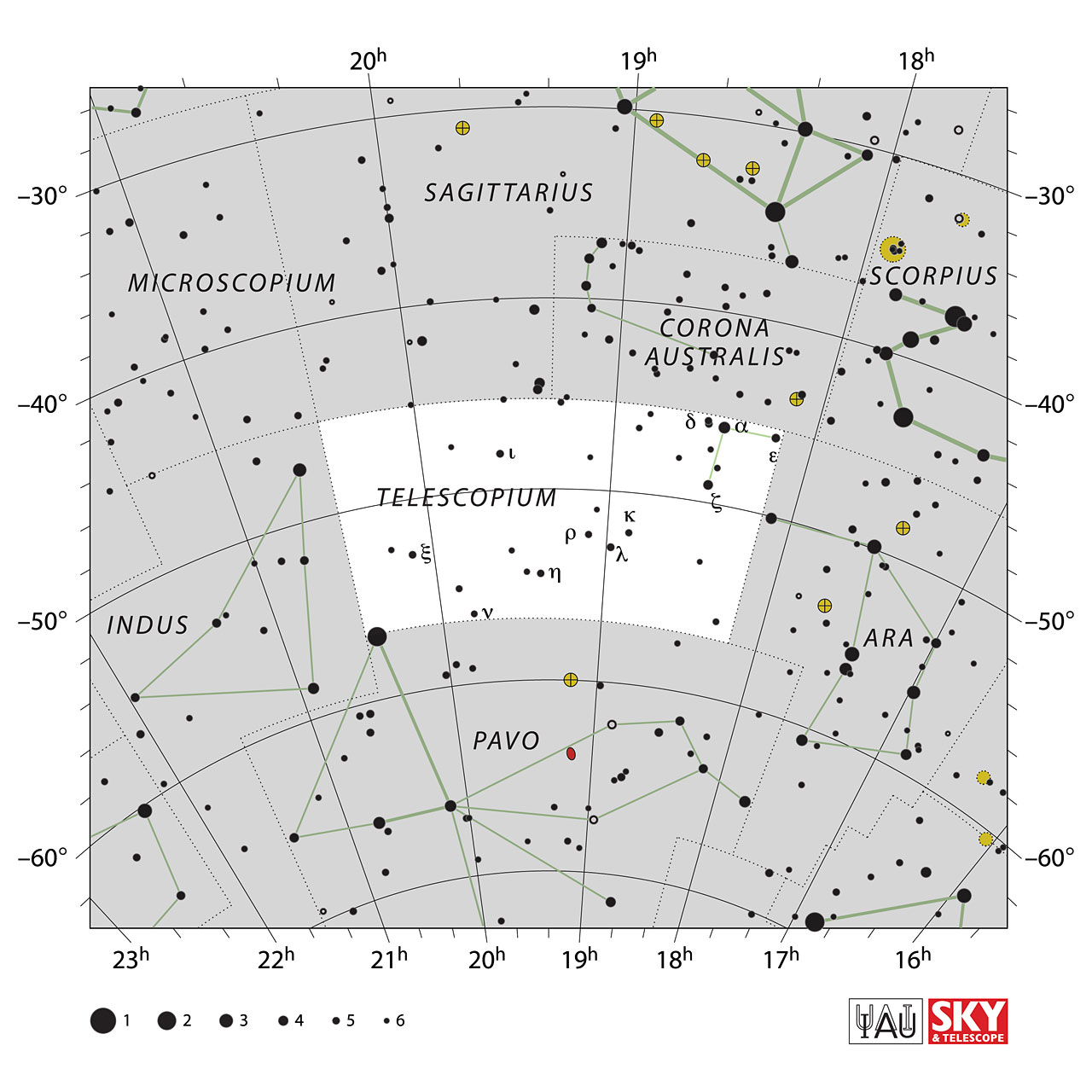Telescopium


Telescopium is a small and faint southern constellation which appears highest in the evening sky in the months around July.
Its name is Latin for ‘telescope’, and was applied to this area of sky by Nicolas Louis de Lacaille in 1756. Lacaille originally depicted an aerial telescope – a unwieldy design of refractor which comprised of lenses attached to very long poles. It is one of several constellations depicting scientific instruments.
The stars which make up the telescope are of fourth magnitude, and this sky area contains only one bright deep sky object: the globular cluster NGC 6584.
In the Indian astronomy system, Telescopium is known as ದೂರದರ್ಶಿನಿ (Dooradarshini).
Telescopium contains:
-
Stars
- α-Tel (mag 3.5)
- ζ-Tel (mag 4.1)
- ε-Tel (mag 4.5)
- λ-Tel (mag 4.8)
- ι-Tel (mag 4.9)
- δ¹-Tel (mag 4.9)
- ξ-Tel (mag 4.9)
- η-Tel (mag 5.0)
- δ²-Tel (mag 5.1)
- κ-Tel (mag 5.2)
- ρ-Tel (mag 5.2)
- ν-Tel (mag 5.3)
- HD 167128 (mag 5.4)
- HD 179886 (mag 5.4)
- HD 169405 (mag 5.5)
- HD 174387 (mag 5.5)
- PW Tel (mag 5.6)
- HD 191829 (mag 5.6)
- HD 170069 (mag 5.7)
- HD 182509 (mag 5.7)
- HD 187420 (mag 5.7)
- HD 183552 (mag 5.8)
- HD 173791 (mag 5.8)
- HD 171819 (mag 5.8)
- HD 187086 (mag 5.9)
-
Open Clusters
- None
-
Globular Clusters
- NGC 6584 (mag 7.9)
-
Galaxy
- NGC 6868 (mag 9.2)
- IC 4889 (mag 11.1)
- NGC 6861 (mag 11.2)
- IC 4797 (mag 11.3)
- NGC 6893 (mag 11.4)
- NGC 6758 (mag 11.6)
- NGC 6887 (mag 11.8)
- NGC 6870 (mag 11.8)
- NGC 6875 (mag 11.8)
- NGC 6909 (mag 11.9)
- IC 4837 (mag 12.2)
- IC 4933 (mag 12.2)
- NGC 6854 (mag 12.3)
- NGC 6754 (mag 12.9)
- NGC 6708 (mag 12.9)
- IC 4956 (mag 13.0)
- NGC 6850 (mag 13.1)
- IC 4832 (mag 13.1)
- IC 4943 (mag 13.2)
- NGC 6848 (mag 13.4)
- NGC 6725 (mag 13.4)
- NGC 6799 (mag 13.4)
- NGC 6899 (mag 13.5)
- IC 4796 (mag 13.5)
- NGC 6780 (mag 13.5)
View Telescopium in 3D 
Source: Wikipedia, in-the-sky.org
Image Courtesy: Sky&Telescope & IAU, Illustration Images linked from Urania's Mirror on Wikmedia Commons by Sidney Hall
Image Courtesy: Sky&Telescope & IAU, Illustration Images linked from Urania's Mirror on Wikmedia Commons by Sidney Hall
